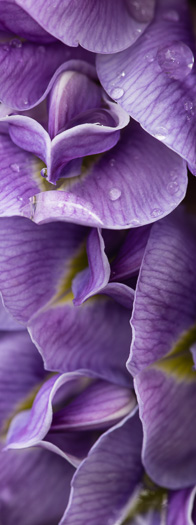Native Wisteria
by Jan Haldeman*
Reprinted from the Winter 2007 Journal of the South Carolina Native Plant Society, and used by permission.
Click the linked names throughout the text to see pictures or additional information.
Let’s say you’re seeking an attractive vine to embellish a fence, trellis or arbor. Are you enamored with the cascading lavender blossoms of Chinese and Japanese wisteria? Before investing in either of these Asian exotics, consider the possible consequences of their aggressive natures. Although their flowers are beautiful, both species can be invasive. In fact, they run rampant throughout parts of the eastern half of the United States where they’ve escaped cultivation. In spring they’re conspicuous along roadsides, blanketing trees and shrubs with thick, heavy growth and flower clusters.
Fortunately, an attractive, non-invasive alternative is available in many nurseries: our native wisteria species, Wisteria frutescens. What’s more, a beautiful cultivar that originated in Oconee County, SC — W. frutescens ‘Amethyst Falls’ — has earned gold-medal awards from plant societies in Florida, Georgia and Pennsylvania. Other attractive native cultivars are available too, with varying blossom colors and flower stalk sizes.
Consider some of the virtues of native wisteria:
- Easy to grow and maintain, as it requires minimal pruning.
- Climbs quickly to cover an arbor, yet doesn’t spread out of control, crush a fence or strangle a tree.
- Usually blooms the first year, whereas Asian species may not bloom for as many as 10 years.
- Numerous 4-inch flower stalks with 25-65 flowers each give the appearance of a lavender waterfall.
- Plants are drought tolerant, even though native wisteria grows naturally near streams and swamps.
- Unappealing to deer. The mildly fragrant lavender blue flowers at tract butterflies and hummingbirds.
Wisteria belongs to the third-largest family of flowering plants, Fabaceae, known as the bean or pea family. This family includes economically important crops grown for food, medicine and timber. Another common term, “legumes,” refers to the plants’ fruits, which are one- to many-chambered pods. (Yes, string beans are fruits!)
Wisteria’s own pods provide a means by which gardeners can distinguish native from exotic species. Pods of Asian wisterias have velvety surfaces due to a thick covering of short hairs, whereas native Wisteria pods are smooth and hairless. Mature seedpods pop open explosively to disperse seeds, and if your native vine produces a good crop, it can be quite a show. But note that the seeds are poisonous.
Native wisteria, also known as Atlantic wisteria, grows naturally throughout most eastern states and several states west of the Mississippi River. The genus name, Wisteria, was established in the 18th century by renowned botanist Thomas Nuttall to honor his friend Caspar Wistar, a physician and patron of botany. The species name, frutescens, means “shrubby,” even though all wisteria species are true vines.
Some botanists also like to recommend its relative, W. macrostachya, commonly known as Kentucky wisteria, which occurs in swamps from Louisiana to Illinois and Kentucky. Horticultural varieties have been developed from both types, and nurseries may offer cultivars with either botanical name, followed by the variety or common name.
Planting native wisteria is just one way gardeners can help conserve plant diversity of the southeastern United States, which is one of the richest in the world. Planting native species returns to our land plants that are being lost to urban development.
* Dr. Haldeman is Professor Emeritus of Biology, Erskine College, and former Chair of the South Carolina Native Plant Society’s Exotic Species Committee.
Which Wisteria do I have?Differences between Chinese and American Wisterias are somewhat subtle, but they can be distinguished if you consider some of the following features: |
||
| Trait | Chinese — Wisteria sinensis | American — Wisteria frutescens |
| Leaflets | Ovate/elliptic, pointed tips | Ovate, pointed & blunt tips |
| Flower raceme | Loose clusters, all flowers on raceme bloom at once. | Tighter clusters, flowers bloom first at base of raceme. |
| Flower stalk (pedicel) | Over 1/2" in diameter | Less than 1/2" in diameter. |
| Flowering time | April/May | June/July |
| Fruit pod (legume) | Large (4-6"), velvety hairy | Smaller (2-4"), glabrous |
| Growth habit | Sprawls as well as climbs | Strong climber into shrubs or small trees |
|
Twining direction can be determined by looking at (or imagining) the vine twining around a branch or pole. Look at the pole or branch from the base (from the direction from which the vine is growing): Both Chinese and American species twine clockwise. Japanese wisteria, Wisteria floribunda, twines counterclockwise, and does occur — though much less frequently. Personal observations of local populations of Wisteria sinensis and Wisteria frutescens show darker rusty brown stems of W. frutescens contrasting to lighter grayish brown stems of W. sinensis. |
||

